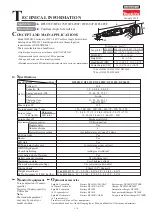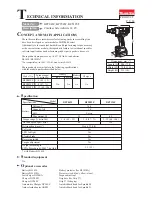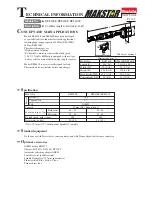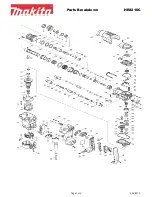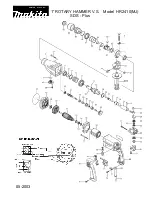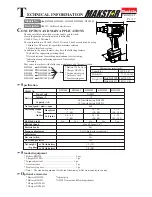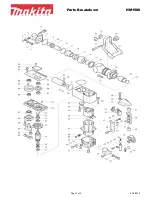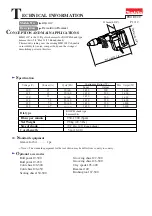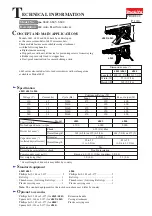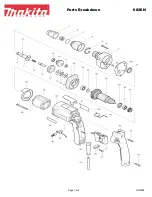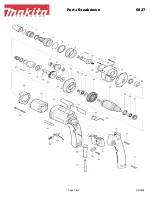
BOP HIPWR 031912
3-3
3.2.2
LCD AND POWER-UP SCREEN DESCRIPTION
The LCD display is a 320 x 240 pixel monochrome window that displays various menus depend-
ing on the state of the power supply and operator input. At the power-up screen, the LCD will
show actual voltage and current at the BOP output, the mode (at the upper right), the function of
the soft keys to the right, help text at the bottom, and main and complementary limit channel set-
tings above the help text.
The power-up screen (Figure 3-3 or Figure 3-4) is presented upon power-up or when all sub-
menus of a function have been exited. This screen shows analog and digital representations of
the actual BOP output in the center of the display.
At the upper right of the display, the mode of operation is displayed:
• Voltage source
• Voltage sink
• Current source
• Current sink
TABLE 3-2. SPECIAL KEY FUNCTIONS
KEY
FUNCTION
STANDBY
The STANDBY key toggles the unit between output on (enabled, STANDBY indicator off) and output off
(disabled, STANDBY indicator on). When on, the output goes to the programmed settings. Behavior of the
unit in Standby (Output off) is determined by the options chosen for Load Type (see PAR. 3.3.6). The
default Load Type is ACTIVE, i.e., in STANDBY the unit is set to voltage mode, voltage is set to zero, cur-
rent protection is set to the nominal, and voltage limit is set to maximum.
MODE
Depressing this key shifts the operating mode from voltage to current and vice versa, and at the same time
sets the unit to STANDBY permitting the user to introduce new settings for the selected operating mode.
The operating mode is indicated at the upper right of the LCD. Setting the unit to STANDBY when the
mode is changed only occurs when using the MODE key.
R
or
T
From the power-up screen, these keys scroll the cursor from digit to digit within a field.
Y
or
U
From the power-up screen, these keys scroll through the main or protection fields. Also used to scroll
though and select options on other menus.
CLEAR
Clears numeric value to 0 (zero). Clears alphanumeric characters for new entry.
+/–
Switches the sign b and – when inputting numerical values. The sign change applies only to the
main channel: voltage in voltage mode, current in current mode.
CAUTION:Pr/– key while the power is applied to the load will reverse the polarity of voltage
applied to the load.
ENTER
Activates highlighted parameters. When setting voltage/current values using the keypad, the values
entered are not programmed until ENTER is pressed.
HELP
Provides context-sensitive help to assist in using the keypad and display to program the unit. Press HELP
repeatedly for more help messages.
!
through
%
The “soft” function keys are software dependent, and will change depending on the operation being per-
formed. The key function is indicated by a box in the LCD which is aligned with the key (see PAR. 3.2.2).
RESET
switch
Switch is recessed and requires the use of a tool to prevent inadvertent activation. Pressing RESET briefly
causes the unit to shut down followed by execution of a power on sequence which results in the unit being
set to the power on defaults (see PAR. 3.3.7). To restore normal operation after a fault has been cleared it
is recommended that the unit be powered off, then on again instead of using the RESET key.
CAUTION:Pressing RESET will cause voltage transients to appear at the output which may damage
a connected load.
Summary of Contents for BOP-MG
Page 2: ......
Page 10: ......
Page 20: ...x BOP 1K 031912 FIGURE 1 1 HIGH POWER BOP SERIES POWER SUPPLY...
Page 37: ...BOP HIPWR 031912 1 17 FIGURE 1 3 BOP OUTPUT CHARACTERISTICS...
Page 53: ...BOP HIPWR 031912 2 15 FIGURE 2 4 PARALLEL CONFIGURATION LOCAL SENSING TYPICAL...
Page 54: ...2 16 BOP HIPWR 031912 FIGURE 2 5 PARALLEL CONFIGURATION REMOTE SENSING TYPICAL...
Page 64: ......
Page 132: ......
Page 192: ......































